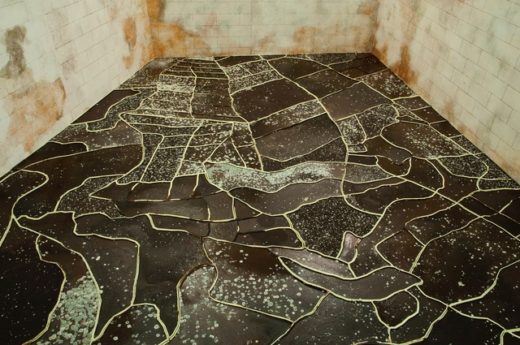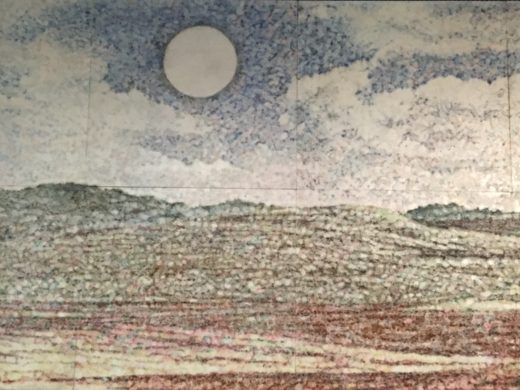Gal Weinstein: Israeli Pavilion 57th Venice Biennale
Cathy Byrd

Israeli Pavilion
57th Venice Biennale
May 13–November 26, 2017
Hope and despair are the two opposing forces at play in Sun Stand Still, the immersive environment that Tel Aviv–based artist Gal Weinstein created for the Israeli Pavilion, organized by Miami-based curator Tami Katz-Freiman, at the 57th Venice Biennale. The exhibition title refers to a biblical miracle performed by Israelite Joshua who commanded the sun to stop its course so he could win a battle before darkness fell. Weinstein counters this righteous conceit by materializing its certain failure, casting a pall over the building’s three levels.
From outside, you wouldn’t see it coming. The white Bauhaus structure remains untouched since Israeli architect Zeev Richter designed it in 1952. Erected at a moment when Jewish people were struggling to re-establish settlements in Israel, the purely modernist pavilion represented a promising future. To step inside the venue is to enter a somber reflection on the rise and fall of optimism in the Zionist movement. Rejecting utopian ideals that date well over a half-century, Weinstein and his team labored for almost a year to transform the pristine interior into a site of abandonment and decay.

At the center of the pavilion, Weinstein depicts a romantic vision still looming large in the Israeli conscience. The dreamy landscape painting Moon Over Ayalon Valley fills an entire wall with the collective memory of Joshua’s divine power. Pausing to look up at this idyllic reverie, one might notice a musty smell creeping across the space. That’s the real mildew permeating Jesreel Valley in the Dark. Although not permitted to enter the room-size floor installation, viewers can observe from two different levels a wall-to-wall expanse of irregular farming tracts that fit together like a puzzle. Each of these shapes is a container that Weinstein and his team filled with brewed coffee grounds during installation. Now in full bloom, velvety white, green, and deep brown mold spores continually alter the surface of this volatile terrain. The effect seems to render the air quality more and more toxic.
For many, the sense of sadness and resignation that is quite literally overtaking the Israeli Pavilion might seem at odds with the mostly sunny disposition of the 57th Venice Biennale. Instead, I believe this year’s biennial curator Christine Macel set the stage for Weinstein’s participation. Choosing “Viva Arte Viva” as the theme, Macel communicated her determination to value art, the artist, and the creative process more than any political agenda. The effect was to acknowledge the relevance of Weinstein’s process-oriented work and enable his realization of a poignant conceptual project. The beauty here is the freedom to represent one consequence of neglecting human rights, to make visible the endless melancholy seeping from the wounded psyches of displaced peoples and darkening the future of the world.
Cathy Byrd is an independent curator and art writer skilled in the art of roving. Her Fresh Art International audio podcast and weekly art talk show feature field recordings and studio sessions with contemporary culture makers from Miami and around the world. Find her at FreshArtInternational.com and JoltRadio.org.










